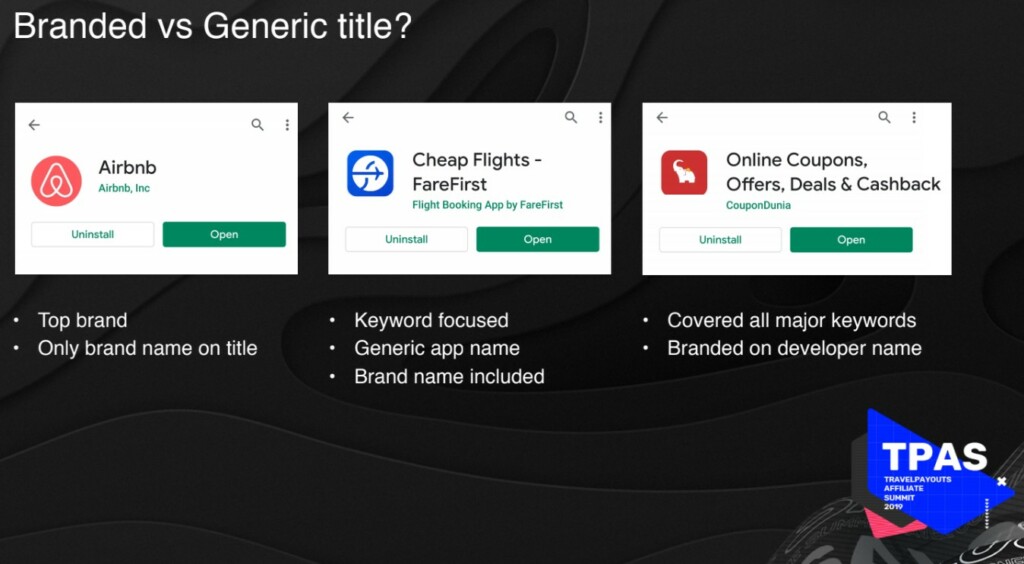How it all started
Jaseel joined the Travelpayouts in 2015. He first created a White Label website and then built a few apps with Travelpayouts SDK, which helped him learn the basics of SEO.
In 2017, Jaseel launched his own company, FareFirst. Today, his app is localized in more than 20 languages, accounting for almost one million installs and over 120,000 active users per month.

How to build an app with Travelpayouts SDK
Creating an app with Travelpayouts SDK is a pretty simple process and doesn’t require coding skills:
- Install Android Studio/Xcode
- Download Travel SDK
- Read the documentation
- Run the code and change basic configurations such as app name and logo
- Add token and affiliate marker
- Extend app functionality (required for listing your app on iOS)
It is not enough to simply create an app to start making money. There are three things to do next:
- ASO
- App store publishing
- Improving
ASO
ASO, which stands for App Store Optimization, is a two-part process. You need to add keywords to improve app visibility in SERP and then optimize the conversion rate. ASO alone helped FareFirst get about 100,000 installs in the first three months, with up to 4,000 installs per day. The graph below shows the changes in the number of installs over time.

To achieve such a result, you can follow in Jaseel’s footsteps:
- Research keywords
- Add keywords to the title and description
- Optimize the app listing page
- Localize the app
- Drive reviews
- Run A/B testing for logos, screenshots, titles, etc.
How to use keywords
Keywords are the most important step towards ASO. To improve app visibility, add them to the app title and short and long descriptions. There is a slight difference in keyword placement on Android versus iOS:

Keywords in the title
There are many ways to name an application. In the screen below, you can see three examples of app titles.

- Airbnb is a well-known brand. When people search for this app, they type in the brand name directly.
- FareFirst’s title includes both brand name and generic keyword, with a greater focus on the latter.
- CouponDunia’s title consists of generic keywords only, while the brand name is written in the “Developer” field.
Jaseel personally recommends choosing the second or the third strategy, as he used both of them and saw radical improvements in the number of app installs.
How to find the right keyword for your title
- Use Play Store/App Store search suggestions, as they show what real customers look for.
- Analyze recently uploaded apps with the biggest number of downloads. With so much traffic, they must have chosen the right keywords.
- Take advantage of keyword research tools such as Apptweak & AppFollow that offer multiple keyword suggestions.
What is the best title?
It should contain the right keywords, realistically represent exactly what the app does and help optimize it. It’s better to use generic keywords and not just a brand name. To find the best option, come up with a few solutions, test them and choose the one that most suits you.
Keywords in the short description
The short descriptions (Android) or subtitles (iOS) occupy a prime spot on your app listing in the store. To generate installs, it should be simple and impressive at the same time.
Remember to add your most important keywords to this field. Below, there is an example of the KAYAK app short description. As you can see, it includes many generic keywords: cheap, flights, hotels, rental, car, app. The word “app” is in the list of ten most popular words that people use to find the desired application, for instance, “app for booking tickets,” or “app with coupons,” etc.

Keywords in the long description
The long description allows for up to 4,000 characters, so there is a lot of space for keywords. The first couple of sentences are most important, because customers can see them from the app listing, and less than 2% of users proceed to the extended description.
Make sure you add all relevant keywords to the long description and maintain a good level of density (2%-3%). Finally, try to make the most of the available space. For example, FareFirst uses 2,500 characters in its long description.
The screen below shows the listing of the eSky app.

The description starts with the words “cheap flights” and then features names of the airlines and hotels. The app ranks fourth and fifth for the keywords “RyanAir” and “WizzAir” on the Google Play Store, and both brands are used twice in the description. This is important because people are looking up low-cost carriers more often, so mentioning brands like these can increase your position in the store.
More keyword opportunities
The next field to use is the Developer name on Android or the Keyword space on iOS (up to 100 characters). By filling in these sections, you can significantly improve your ranking. Then, take advantage of the “What’s new” field. Earlier, it was possible to add keywords in the package name, but it doesn’t work this way anymore.
Keywords to focus on
In order to increase the number of installs, pay close attention to high volume and low competition keywords, long tail keywords (despite lower popularity, they can boost your app ranking by a lot), brand names (they have high search volume and relatively low competition) as well as your competitors’ keywords.
How to find keywords
Use tools for app optimization. AppTweak is great for competitor analysis. It allows you to find the keywords that drive downloads for competitive apps, checks what keywords they rank for and tracks their growth. AppTweak also shows keyword search volume (on a scale from one to 100), ranking the difficulty and the chances of getting listed on the top for this keyword.
Competitor analysis is a crucial factor for success. Find out which keywords drive installs for similar apps, check their search volume and ranking difficulty and then add them to your store listing.
Another great tool is AppFollow. It is cheaper than AppTweak and has great functionality also.
Find more useful tools for your app optimization in the picture below.

How to optimize your app for a better conversion
There are five major elements that influence your app conversion: icon, screenshots, promo video, featured images (for Play Store only) and proper tags (for Play Store only). Here are some tips on optimization:
- Your icon gives the first impression, so make sure it clearly represents what you do and differentiates you from competitors. Avoid logos with lots of text because they hard to read.
- Screenshots show up in both the search results and on the app page for iOS, and only on the app page for Android. Screenshots need to be better optimized for iOS for this reason. For example, try to create a panoramic experience and visually connect first three screenshots. You can do this with the help of the tools below:

- Set American English as the default language if you’re targeting worldwide.
- Upload the Privacy Policy before publishing your app to avoid a ban from Google. There are many free online privacy policy generators that you can use.
- PlayStore and AppStore are not the only places to be, especially when you target countries such as China, so make sure to explore alternatives like Amazon Store, MI Store, Huawei Store, Getjar, etc.
After publishing
It’s time to share your app with family and friends. Jaseel recommends sending the app name or screenshots and not the link. This will help improve the app position in the store. Then, ask your friends to write a detailed review and not just “What a cool app!” If you keep doing it for a week or two, the keywords in the app title and description will start to gain weight.
Therefore, publish your app, let a little time pass, and then start sharing it and collecting reviews. These simple steps will help you get a good position in the store.
Reviews are just as important for driving downloads, so try to get as much positive feedback as possible. Don’t panic if someone leaves a negative review, and remember that replying builds credibility. To collect reviews, use a two-step pop-up notification for measuring customer satisfaction. Ask users to rate your app if they like it or leave feedback if not.
Localization
Localization is the next crucial step. The graph below shows an increase in the number of downloads of the FareFirst app since the start of localization.

Here are the elements of an app that need localized:
- Title
- Short description/Subtitle
- Long description
- Screenshots
- Featured graphics
- Keyword field (for iOS)
- Logo (if there is text)
- Promo video
Upload the original app to the store and wait for optimization tips from Google. Then, you can start localizing for the top ten languages based on download statistics, paying particular attention to popular languages such as German, Spanish, Italian, Russian, etc. Create screenshots for both mobile devices and tablets.
Also, build a semantic keyword dictionary and upload it to the localized file. To find semantic keywords, Jaseel uses AppTweak. This is how it works: find your competitor’s application, change the country and the language, open the keyword finder, check the top-ranked semantic keywords and add them to your store listing.
Improving
At the beginning of the promotion, ads can boost the app position by a lot and can also improve the keyword ranking.
Another important step is to run A/B testing. It allows you to try out various logos, featured graphics, promo videos, short and long descriptions as well as screenshots. For example, you can set seasonal-specific screenshots for Christmas or any other holiday to boost installs.
Remember to improve your app on a regular basis. Here are the key things to keep an eye on:
- UI in app
- Localization
- Features
- Push notifications
- Rating screen
- User login
How to succeed
Build a successful application by:
- Choosing the perfect app title
- Including as many keywords as possible
- Collecting reviews
- Localizing the app with high search volume semantic keywords
- Doing keyword research
- Running A/B tests
- Improving the application
One more thing to remember: it is not enough to just attract customers, you also need to retain them. Push-notifications, email newsletters and retargeting will do the trick. For instance, FareFirst sends notifications twice a month and on special occasions.
To learn more about app optimization and improvement, consider checking out the tools:
It is also important to use analytics services to monitor your campaign efficiency and be able to adjust it along the way. For instance, in the beginning, Jaseel used the Google Play Console and some regular analytics tools, but now he prefers Firebase.
Slides
If you want to learn more about building an app with Travelpayouts SDK, check our knowledge base and blog articles.



